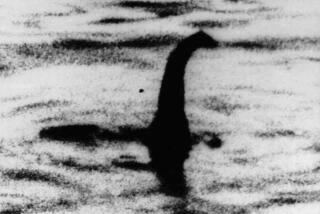Sea Serpent Glides Into Folklore of Canadians
VANCOUVER, Canada — For centuries, native Indians on Canada’s west coast have reported sightings of a sea serpent similar to the Loch Ness monster speeding through Pacific waters.
Now two British Columbia scientists have pieced together what they believe is compelling evidence of the existence of the fabled, long-necked creature known as Cadborosaurus.
They say that in the past l0 years at least six specimens of the sea creature have been discovered, including a live baby and a dead youngster found undigested in the stomach of a whale.
Marine biologist Ed Bousfield says he and fellow researcher Paul LeBlond, a University of British Columbia oceanographer, will present their findings in December to the American Society of Zoologists.
The researchers say in their paper that “evidence strongly supports the recognition of this animal as a distinct vertebrate species.”
Bousfield says he himself is convinced that the serpent with the small head, affectionately known as Caddy, is not simply a figment of the imagination of ancient Indians, grizzled sailors and tourism promoters.
“I’m convinced it exists. We have a mountain of evidence and all we lack is a current specimen. All attempts to track down the previous specimens have been fruitless because of the long passage of time,” he said in an interview from the British Columbia capital of Victoria.
LeBlond also finds the research convincing. “If you put probability on a scale of one to 10, it was seven. Now it’s eight,” he says.
Bousfield says Caddy looks like a dinosaur, lives mainly in ocean depths, eats fish and probably bears its young in warmer, coastal waters.
As an adult, the creature measures 40 to 60 feet and has been clocked swimming at 25 m.p.h. “It can outrun a killer whale,” he says.
Bousfield adds that since World War II two skeletons and two carcasses of what appear to be Caddies have washed up on the shores of British Columbia and neighboring Washington State.
The most convincing seems to be that of a 10-foot long juvenile found in 1937 in the stomach of a sperm whale at a whaling station on the Queen Charlotte Islands.
In 1968, a 16-inch baby apparently was captured live by a former whaling captain who put it in a bucket for the night on his ship--but took pity on it in the morning and released it.
Bousfield, a research associate with the Royal British Columbia Museum, says there has been one sighting of a Caddy a year on average for the last 100 years.
“How many giant squids do we see each year? None. And there’s millions of them down there,” he says.
Cadborosaurus gets its nickname from a newspaper contest held in 1933 after several sightings in Victoria’s Cadboro Bay.
Bousfield says the creature is probably related to the Loch Ness monster and other European lake serpents.
It is also similar to Ogopogo, a legendary serpent sighted regularly in Lake Okanagan, an 80-mile-long lake in the British Columbia interior with a maximum depth of about 1,000 feet.
Okanagan author Arlene Gaal says she herself has seen the monster three times in last 12 years. “We’re looking at an animal that has an elephant-like body, a front appendage and a long tail,” she says.
She believes Ogopogo, like the Loch Ness monster and other lake creatures, is a throwback to the age of the dinosaurs. It may even be a plesiosaur.
“It’s of some prehistoric form, but of some form that has adapted to lake conditions over the years,” she says.
Skeptics have suggested that Ogopogo is simply a clever tourist promotion for the resort community of Kelowna, 200 miles east of Vancouver.
But Gaal says that as recently as June a local couple videotaped the monster. “It created a massive, frothing wake and they could see solid body portions moving through the water,” Gaal says.
Ogopogo, meanwhile, has received official approval of sorts. Last fall, Canada’s postal service used an artist’s rendition of it on its stamps.
More to Read
Sign up for Essential California
The most important California stories and recommendations in your inbox every morning.
You may occasionally receive promotional content from the Los Angeles Times.










